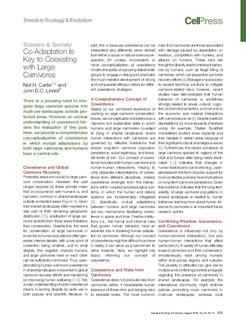| dc.contributor.author | Carter, Neil H. | |
| dc.contributor.author | Linnell, John Durrus | |
| dc.date.accessioned | 2018-09-10T13:51:38Z | |
| dc.date.available | 2018-09-10T13:51:38Z | |
| dc.date.created | 2016-09-30T15:12:54Z | |
| dc.date.issued | 2016 | |
| dc.identifier.citation | Trends in Ecology & Evolution. 2016, 31 (8), 575-578. | nb_NO |
| dc.identifier.issn | 0169-5347 | |
| dc.identifier.uri | http://hdl.handle.net/11250/2561814 | |
| dc.description.abstract | There is a pressing need to integrate large carnivore species into multi-use landscapes outside protected
areas. However, an unclear understanding of coexistence hinders the realization of this goal. Here, we provide a comprehensive conceptualization of coexistence in which mutual adaptations by both large carnivores and humans have a central role. | nb_NO |
| dc.language.iso | eng | nb_NO |
| dc.title | Co-adaptation is key to coexisting with large carnivores | nb_NO |
| dc.type | Journal article | nb_NO |
| dc.type | Peer reviewed | nb_NO |
| dc.description.version | publishedVersion | nb_NO |
| dc.subject.nsi | VDP::Samfunnsgeografi: 290 | nb_NO |
| dc.subject.nsi | VDP::Human geography: 290 | nb_NO |
| dc.subject.nsi | VDP::Mathematics and natural science: 400::Zoology and botany: 480 | nb_NO |
| dc.source.pagenumber | 575-578 | nb_NO |
| dc.source.volume | 31 | nb_NO |
| dc.source.journal | Trends in Ecology & Evolution | nb_NO |
| dc.source.issue | 8 | nb_NO |
| dc.identifier.doi | 10.1016/j.tree.2016.05.006 | |
| dc.identifier.cristin | 1388345 | |
| dc.relation.project | Norges forskningsråd: 251112 | nb_NO |
| dc.relation.project | Norges forskningsråd: 250290 | nb_NO |
| cristin.unitcode | 7511,2,0,0 | |
| cristin.unitname | Avdeling for terrestrisk økologi | |
| cristin.ispublished | true | |
| cristin.fulltext | original | |
| cristin.qualitycode | 2 | |
